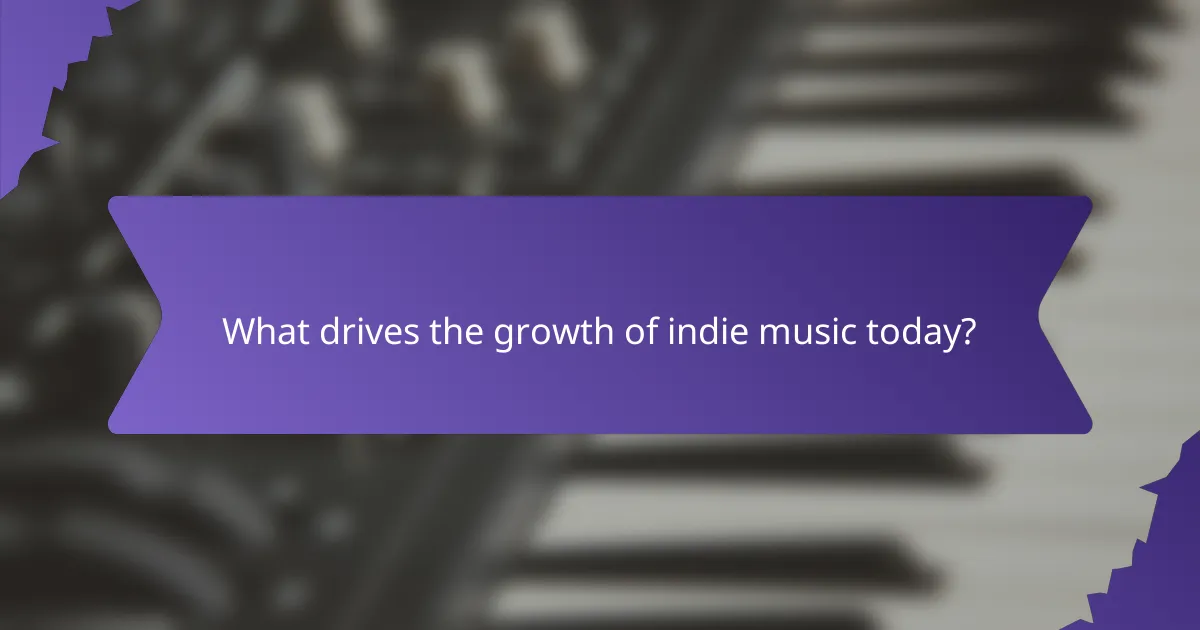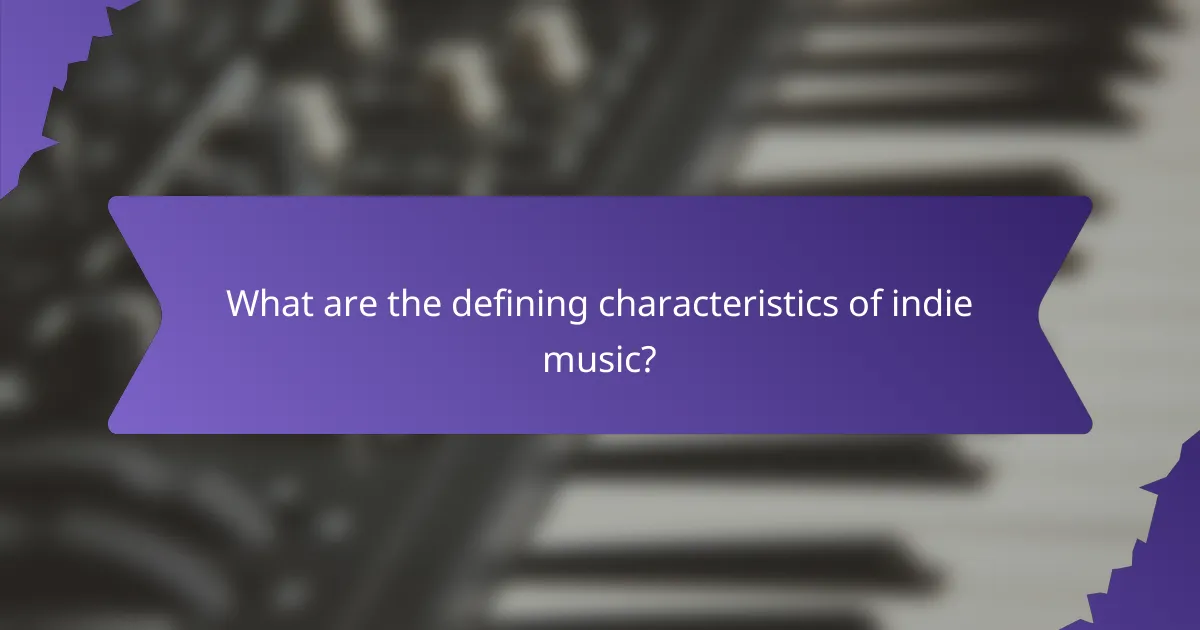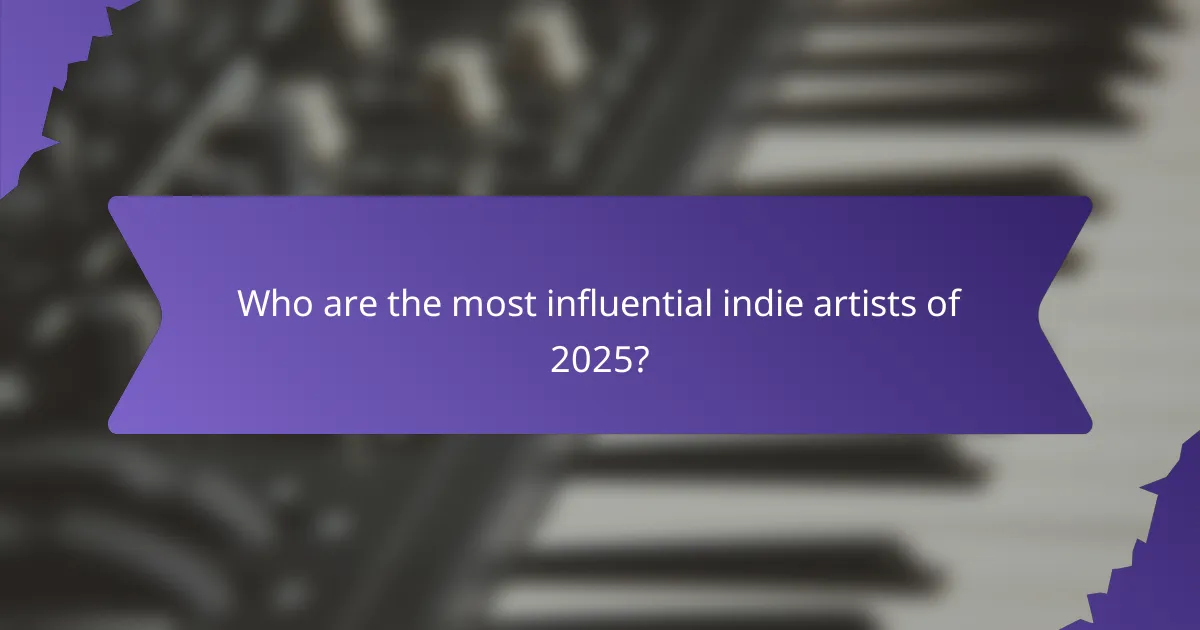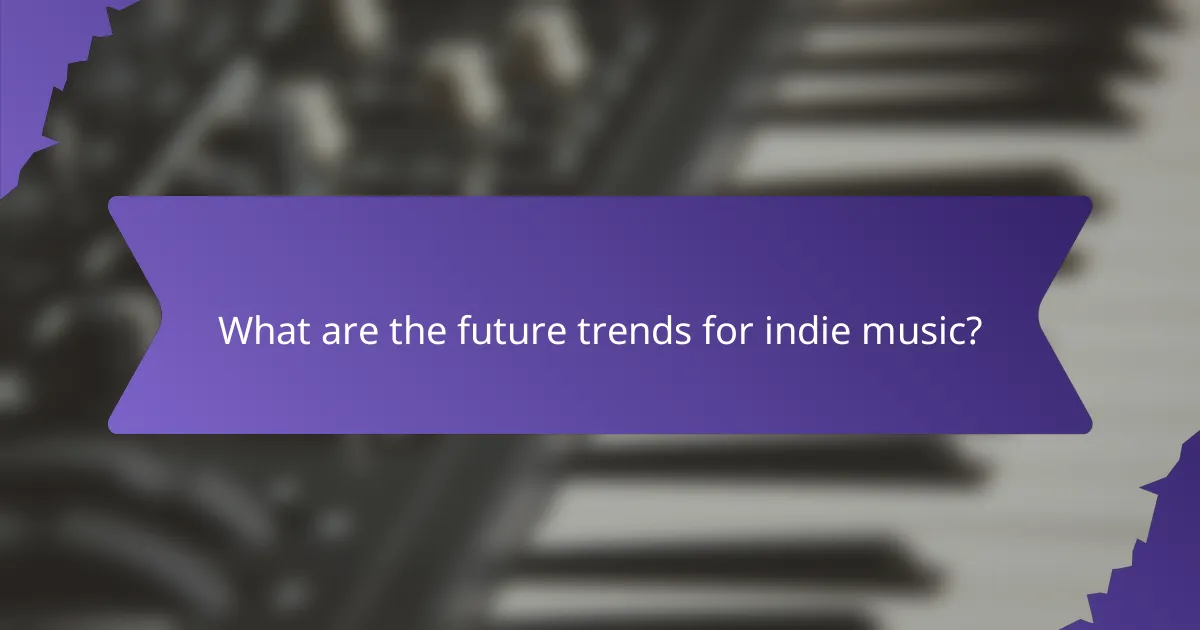Indie music is experiencing significant growth fueled by digital platforms and grassroots promotion. This genre is marked by independent production, diverse sounds, and a strong emphasis on authenticity. Notable artists like Phoebe Bridgers and Mitski are reshaping the landscape with innovative styles and impactful lyrics. However, indie musicians face challenges such as funding and market saturation while navigating a crowded digital space.

What drives the growth of indie music today?
The growth of indie music today is driven by digital platforms and grassroots promotion. Streaming services like Spotify and Bandcamp enable artists to reach global audiences without major label support. Social media fosters community engagement and allows for direct interaction between artists and fans. Additionally, the rise of DIY culture empowers musicians to produce and distribute their work independently. As a result, indie music thrives on authenticity and diverse sounds, reflecting a wide range of influences and experiences.
How has technology influenced indie music distribution?
Technology has significantly transformed indie music distribution by enabling artists to reach broader audiences without traditional gatekeepers. Digital platforms like Bandcamp and SoundCloud allow independent musicians to share their work directly with fans. This democratization of distribution reduces costs and increases accessibility for emerging artists. Additionally, social media has become a vital tool for promotion, allowing for targeted marketing and community engagement. The rise of streaming services has also influenced revenue models, shifting from album sales to streaming royalties, which impacts how indie artists monetize their music.
Which platforms are most popular for indie music discovery?
The most popular platforms for indie music discovery are Spotify, Bandcamp, SoundCloud, YouTube, and Instagram. These platforms offer unique features that cater to indie artists and listeners.
Spotify provides curated playlists and algorithm-driven recommendations, enhancing user experience. Bandcamp allows artists to sell music directly, fostering direct fan engagement. SoundCloud is known for its user-generated content and community interaction. YouTube serves as a visual platform for music videos and live performances. Instagram offers promotional tools for artists to connect with fans through visuals and stories.
Each platform supports indie music’s growth by facilitating accessibility and visibility for emerging artists.
Why do audiences gravitate towards indie music over mainstream?
Audiences gravitate towards indie music over mainstream due to its authenticity and emotional depth. Indie music often reflects personal experiences and diverse perspectives, resonating with listeners seeking genuine connections. Additionally, the DIY ethos of indie artists fosters a sense of community and individuality. This contrasts with mainstream music, which can prioritize commercial appeal over artistic expression. Notable indie artists like Sufjan Stevens and Phoebe Bridgers exemplify this unique approach, drawing dedicated fanbases.
What role do music festivals play in the indie scene?
Music festivals significantly enhance the indie scene by providing exposure and community engagement for emerging artists. These events foster networking opportunities, allowing artists to connect with peers and industry professionals. Festivals often showcase diverse music styles, reflecting the unique attributes of indie music. They create a platform for fans to discover new talent, contributing to the growth of the indie genre. Additionally, festivals can boost local economies and promote cultural exchange, enriching the overall music landscape.
How do regional differences affect indie music trends?
Regional differences significantly shape indie music trends by influencing genre preferences, artist development, and audience engagement. For instance, cities like Seattle and Austin foster distinct sounds, reflecting local culture and history. These regional characteristics create unique indie music scenes, often leading to the emergence of local artists who resonate with specific demographics. Additionally, the availability of venues and community support can enhance the growth of indie music in certain areas, making them hubs for innovation and experimentation.

What are the defining characteristics of indie music?
Indie music is characterized by its independent production, diverse sound, and artistic freedom. Artists often prioritize authenticity over commercial success. Unique attributes include a DIY ethos and a focus on niche genres. Rarely, indie music incorporates unconventional instruments or experimental styles, enriching its overall diversity.
How does indie music differ from mainstream genres?
Indie music differs from mainstream genres primarily in its production, distribution, and creative freedom. Indie artists often prioritize artistic expression over commercial success, leading to diverse sounds and innovative styles. Unlike mainstream genres, which are typically shaped by major record labels, indie music embraces a DIY ethos, allowing for unique storytelling and personal themes. Notable indie artists like Sufjan Stevens and Phoebe Bridgers exemplify this distinctive approach, focusing on authenticity rather than mass appeal.
What themes and styles are prevalent in indie music?
Indie music often features themes of authenticity, introspection, and social commentary. Styles range from lo-fi and folk to experimental rock and electronic influences. Notable characteristics include a DIY ethos, diverse instrumentation, and a focus on lyrical depth. Artists like Bon Iver and Tame Impala exemplify these traits, pushing genre boundaries while maintaining a distinct indie sound.
Which instruments and production techniques are commonly used?
Indie music commonly uses instruments like guitars, keyboards, and drums, along with production techniques such as home recording and digital audio workstations. These choices reflect the genre’s emphasis on authenticity and creativity. Notable techniques include layering vocals, experimenting with sound effects, and utilizing unconventional song structures. The DIY approach allows artists to maintain artistic control and explore diverse musical styles.

Who are the most influential indie artists of 2025?
The most influential indie artists of 2025 include artists who have redefined the genre through innovative sounds and impactful lyrics. Their contributions reflect the evolving landscape of indie music, characterized by diverse influences and a strong connection to audiences. Notable figures include:
1. Phoebe Bridgers | Known for her introspective songwriting and collaborations.
2. Sufjan Stevens | Blends orchestral arrangements with folk elements.
3. Mitski | Recognized for her haunting melodies and emotional depth.
4. Snail Mail | Celebrated for her raw authenticity and guitar-driven sound.
5. Yves Tumor | Fuses experimental rock with electronic influences.
6. Big Thief | Praised for their intricate storytelling and unique soundscapes.
Which emerging artists are making waves in the indie scene?
Several emerging artists are gaining recognition in the indie scene. Notable names include Snail Mail, known for her introspective lyrics and melodic sound. Another rising star is Phoebe Bridgers, whose unique storytelling captivates listeners. Additionally, Yves Tumor pushes genre boundaries with experimental sounds. These artists exemplify the diversity and innovation within indie music today.
How have established indie artists shaped the genre?
Established indie artists have significantly shaped the genre by pushing creative boundaries and influencing mainstream music. Their unique sounds and DIY ethos fostered a culture of artistic freedom. For example, artists like Bon Iver and Sufjan Stevens introduced innovative production techniques, blending genres and redefining what indie music could be. Their impact is evident in the increasing acceptance of diverse musical styles within the mainstream, encouraging new artists to experiment. This evolution has expanded the audience for indie music, making it a vital part of the contemporary music landscape.
What are the unique contributions of regional indie artists?
Regional indie artists contribute unique sounds and perspectives that reflect their local cultures. They often blend traditional elements with contemporary styles, creating distinct musical identities. This diversity enriches the indie music scene, allowing for innovative storytelling and experimentation. Additionally, regional artists foster community engagement through local performances and collaborations, strengthening cultural ties. Their grassroots approach often leads to authentic connections with audiences, setting them apart from mainstream counterparts.

What challenges do indie artists face in the current landscape?
Indie artists face significant challenges in the current landscape, including funding, visibility, and market saturation. Limited financial resources restrict promotional activities and production quality. The digital space is crowded, making it difficult for indie musicians to stand out. Additionally, navigating streaming platforms and social media algorithms adds complexity to audience engagement.
How do financial constraints impact indie music production?
Financial constraints significantly limit indie music production capabilities. Budget restrictions affect recording quality, marketing reach, and distribution options. Independent artists often rely on crowdfunding or personal savings, impacting their creative freedom. As a result, many prioritize essential expenses over innovative projects, which can stifle artistic growth.
What are the implications of limited marketing resources?
Limited marketing resources can hinder indie music growth by restricting visibility and outreach. This constraint affects artist promotion, audience engagement, and overall brand development. Without adequate funding, indie musicians may struggle to utilize effective marketing channels, which can lead to slower audience acquisition and diminished opportunities for collaboration. Additionally, limited resources can impact the ability to produce high-quality promotional materials, further affecting public perception and market competitiveness.
How can indie artists navigate industry gatekeeping?
Indie artists can navigate industry gatekeeping by building strong networks and leveraging online platforms. Establishing connections with other musicians and industry professionals fosters collaboration and visibility. Utilizing social media and streaming services enhances exposure and allows direct engagement with audiences, bypassing traditional gatekeepers. Additionally, participating in local music events and festivals can create opportunities for recognition and support. Emphasizing unique artistic identity helps indie artists stand out in a crowded market.

What are the future trends for indie music?
Indie music is expected to grow through increased digital access, diverse genres, and innovative marketing strategies. Artists will leverage social media to connect with audiences directly. The rise of platforms like Bandcamp and SoundCloud will empower independent musicians to distribute their work without traditional labels. Additionally, collaborations across genres will become more common, enhancing creativity and reach. The emphasis on authenticity will continue to resonate with listeners, shaping the future landscape of indie music.
Which genres are likely to influence indie music in the coming years?
Indie music will likely be influenced by genres such as electronic, folk, and hip-hop in the coming years. Electronic music’s production techniques are increasingly adopted by indie artists. Folk’s storytelling elements resonate with indie’s lyrical focus. Hip-hop’s rhythmic innovation and collaboration culture are also shaping indie sounds. These genres bring fresh perspectives, ensuring indie music’s evolution.
How is the audience for indie music expected to evolve?
The audience for indie music is expected to grow significantly as more listeners seek authenticity and diversity in sound. This evolution is driven by increased access to streaming platforms and social media, enabling independent artists to reach wider audiences. Notable trends include a rise in genre-blending, attracting listeners from various musical backgrounds. Additionally, younger demographics are showing a preference for indie music, valuing its unique attributes over mainstream offerings.
What innovations are on the horizon for indie music production?
Innovations on the horizon for indie music production include advancements in technology, collaborative platforms, and AI-driven tools. Emerging software allows artists to create high-quality music from home, making production more accessible. Cloud-based collaboration tools enable seamless teamwork across distances, fostering creativity. AI technology offers new ways to generate sounds and assist in songwriting, enhancing the creative process. These innovations empower indie artists to produce music that stands out in a competitive landscape.
What best practices can indie artists adopt for growth?
Indie artists can adopt several best practices for growth, including building a strong online presence, engaging with fans, and collaborating with other musicians. Consistent content creation across platforms enhances visibility. Utilizing analytics helps artists understand their audience better. Networking within the music community can lead to valuable opportunities. Emphasizing authenticity in their music and branding fosters deeper connections with listeners.